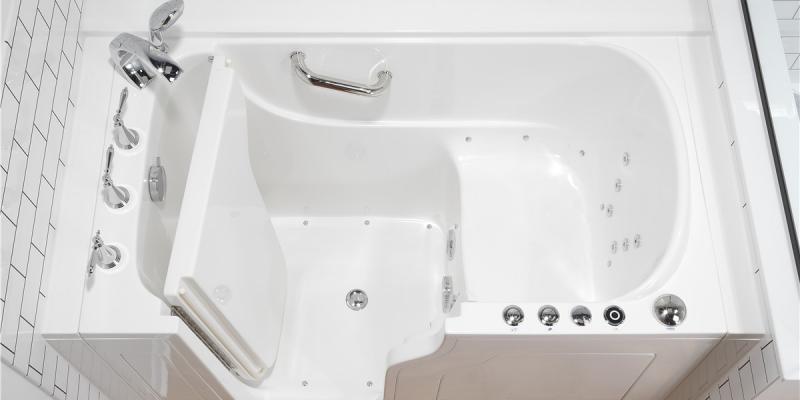Buying A Walk-In Tub? Read This Before You Do

Walk-in tubs are going to solve all your bathing problems if you believe all you hear from your local salesman. However, they are certainly not for everyone. Before you spend a fortune, here are four problems with walk-in tubs that you might experience.
Problems with Walk-in Tubs
You Have To Walk In
If you can walk and are steady on your feet, then you might benefit from a walk-in bath. However, for those that are in wheelchairs or recovering from a stroke or surgery, a slide-in bath would probably be more useful.
You will still find it incredibly difficult to get into and, if your condition worsens in the future, you might even find it impossible. Walk-in tubs are so expensive that you need to make sure that you will get your money's worth.
They Aren't That Comfortable
Walk-in baths are often said to offer the elderly and infirm a return to the comfort of their tub before they were less mobile. The truth is that they don't. You can't just fill up a walk-in and dive straight in - you have to sit there while it fills up.
You can't lie down - you will just be sat there with a straight back on what can be an uncomfortable seat. And you'll still be sitting there in the cold when the bath is draining. If none of this sounds appealing, then perhaps a walk-in tub isn't for you. You may even have to spend more to get a good adjustable lift chair to help you.
Not Easy To Use, Even With Help
If you have a carer helping you in and out of the bath, it can be incredibly difficult for them. The tubs are usually very small and tight. And when you bear in mind that you will have no clothes on - and you will be wet - it will be very hard for them to get a good hold on you to help you out safely.
Wider doors are better, of course, but it will still be hard for you to have a nice experience in the bath, whatever a salesman might tell you.
You May Not Get Health Insurance Coverage
Many people wonder whether walk in tubs are covered by medicare. Does blue cross blue shield cover walk-in tubs? Although you may see your walk-in tub as a necessity, you may not get help with the costs from your insurance company. This could be the case whether your health coverage is with Anthem Blue Cross Blue Shield as a young person, or you are a senior with a Medicare plan in place.
The reason? It involves a change to the home and is not classed as medical equipment, which Medicare B and Medicaid do cover. It is important to check your Medicare and insurance plans before investing in what can be a very expensive piece of equipment.
Does Blue Cross Blue Shield cover walk-in tubs?
The article mentions that many people wonder whether walk-in tubs are covered by insurance companies like Blue Cross Blue Shield. It is important to note that walk-in tubs may not be classified as medical equipment, and therefore, may not be covered by certain health insurance plans, including those under Blue Cross Blue Shield. It is recommended to check your specific insurance plan and consult with your insurance provider to determine coverage and eligibility.
They Aren't Incredibly Safe
If you are unsteady on your feet, then walk-in tubs could cause you problems. There is usually a step to get up, and then you might have to twist yourself around to sit down.
The doorways are often very narrow and difficult to navigate through and, of course if there is an emergency you have no way of getting out. The door cannot be opened until your bath has drained.
Whether you are buying a walk-in tub for yourself or trying to help a loved one who has mobility issues, there is a lot to think about. We hope this article has shone a light on some of the problems you could encounter.
FAQs
Are walk-in tubs suitable for individuals in wheelchairs or those recovering from surgery?
Walk-in tubs may not be the most suitable option for individuals who are in wheelchairs or are recovering from a stroke or surgery. For such individuals, a slide-in bath may be more useful and accessible. It is crucial to assess individual needs and mobility levels before investing in a walk-in tub.
Are walk-in tubs comfortable?
Comfort can be subjective, but the article suggests that walk-in tubs may not offer the same level of comfort as traditional tubs. Users cannot lie down in walk-in tubs and may have to sit with a straight back on a potentially uncomfortable seat while the tub fills and drains.
Are walk-in tubs easy to use with the help of a carer?
The article points out that even with the help of a carer, using walk-in tubs can be challenging. The tubs are usually very small and tight, making it difficult for carers to assist users safely, especially when users are wet and have no clothes on.
Are walk-in tubs safe for individuals who are unsteady on their feet?
Safety is a significant concern with walk-in tubs, especially for individuals who are unsteady on their feet. The article mentions that there is usually a step to get up, and users might have to twist themselves around to sit down. The doorways of walk-in tubs are often very narrow and difficult to navigate through, posing additional safety risks.
Can walk-in tubs be considered a necessity by insurance companies?
Walk-in tubs are often not considered a necessity by insurance companies as they involve a change to the home and are not classed as medical equipment. Therefore, users may not get help with the costs from their insurance company and should verify their Medicare and insurance plans before investing in a walk-in tub.
More Resources: write for us health | write for us elder care | Insurance Guide
More to Read:
Previous Posts:
Next Posts:




